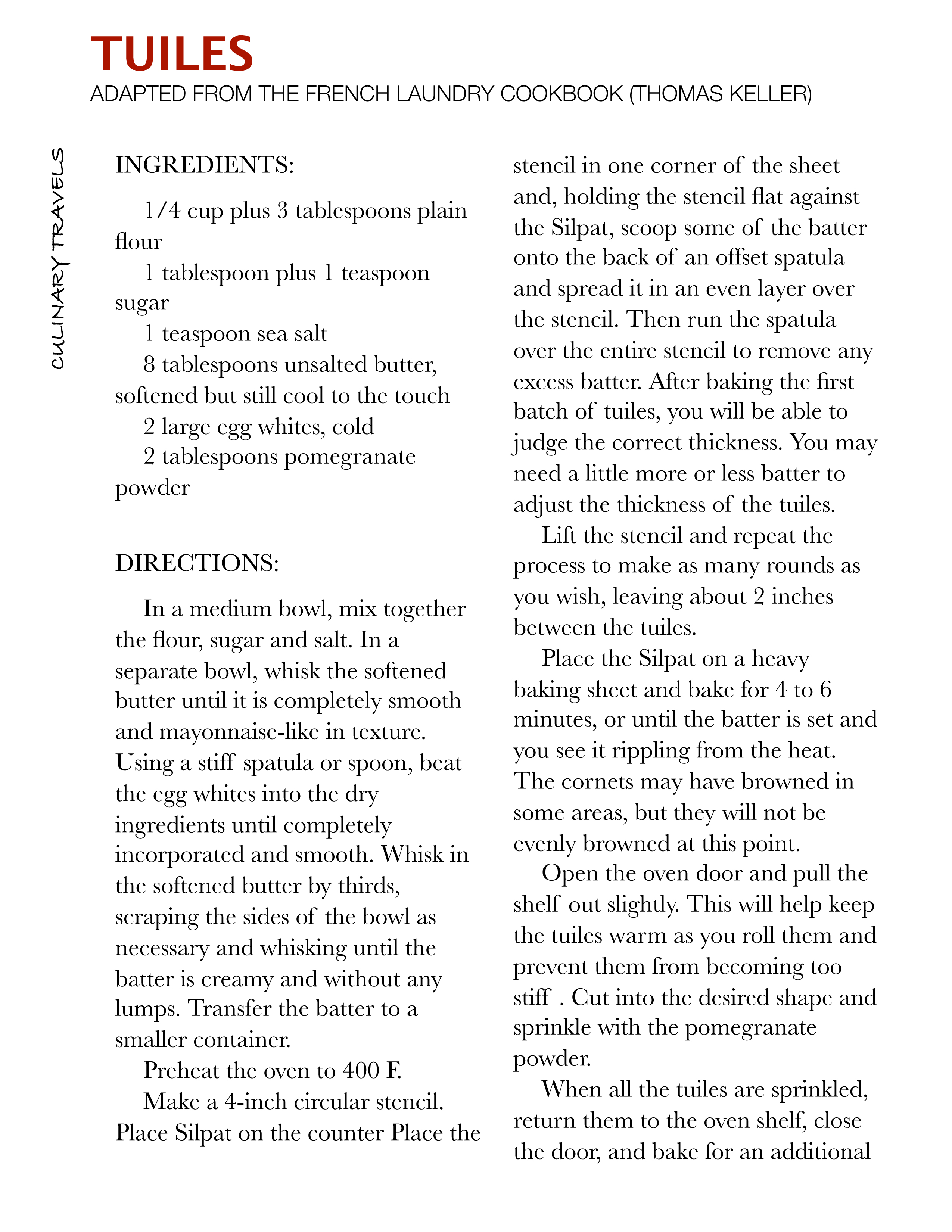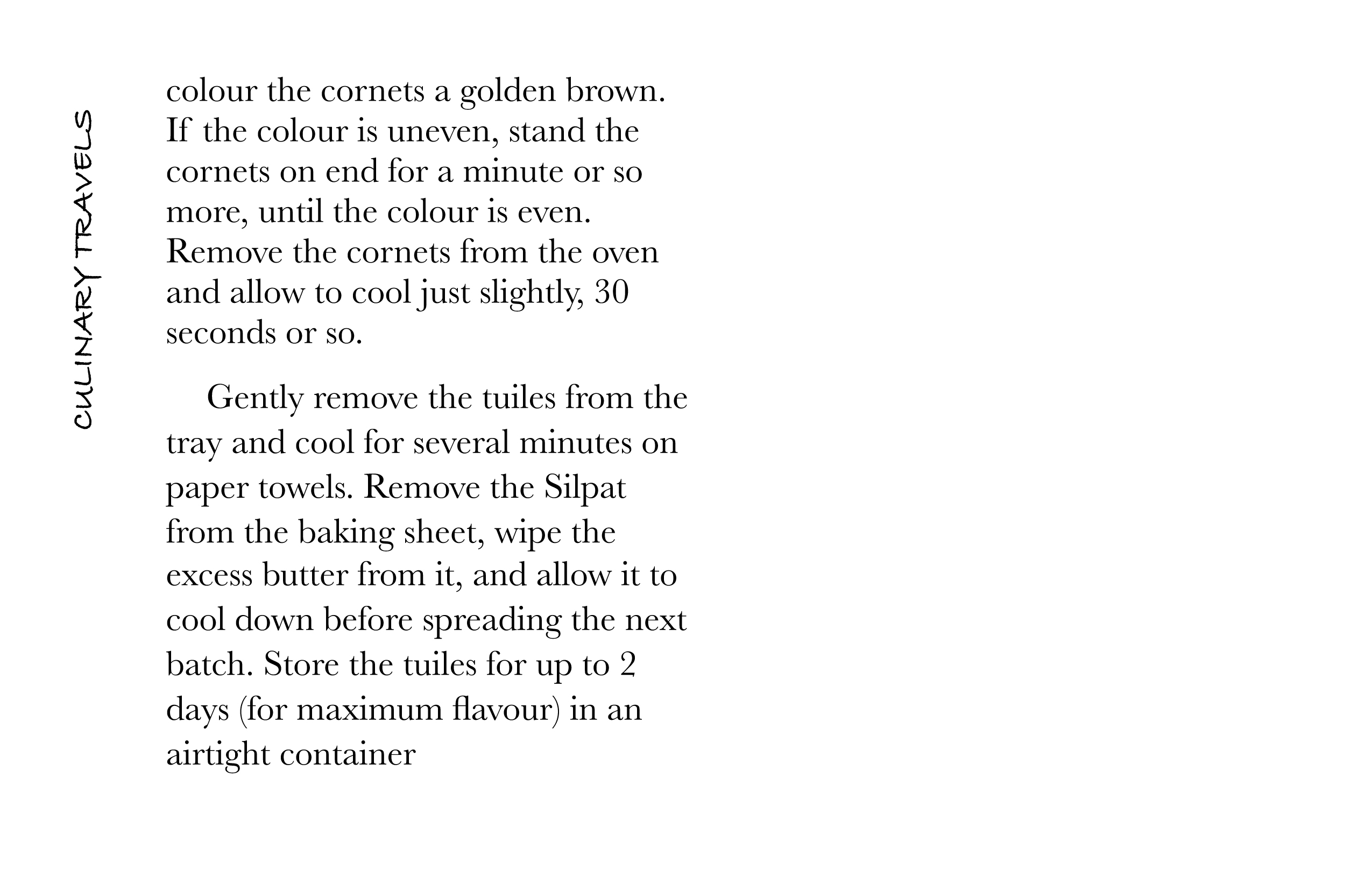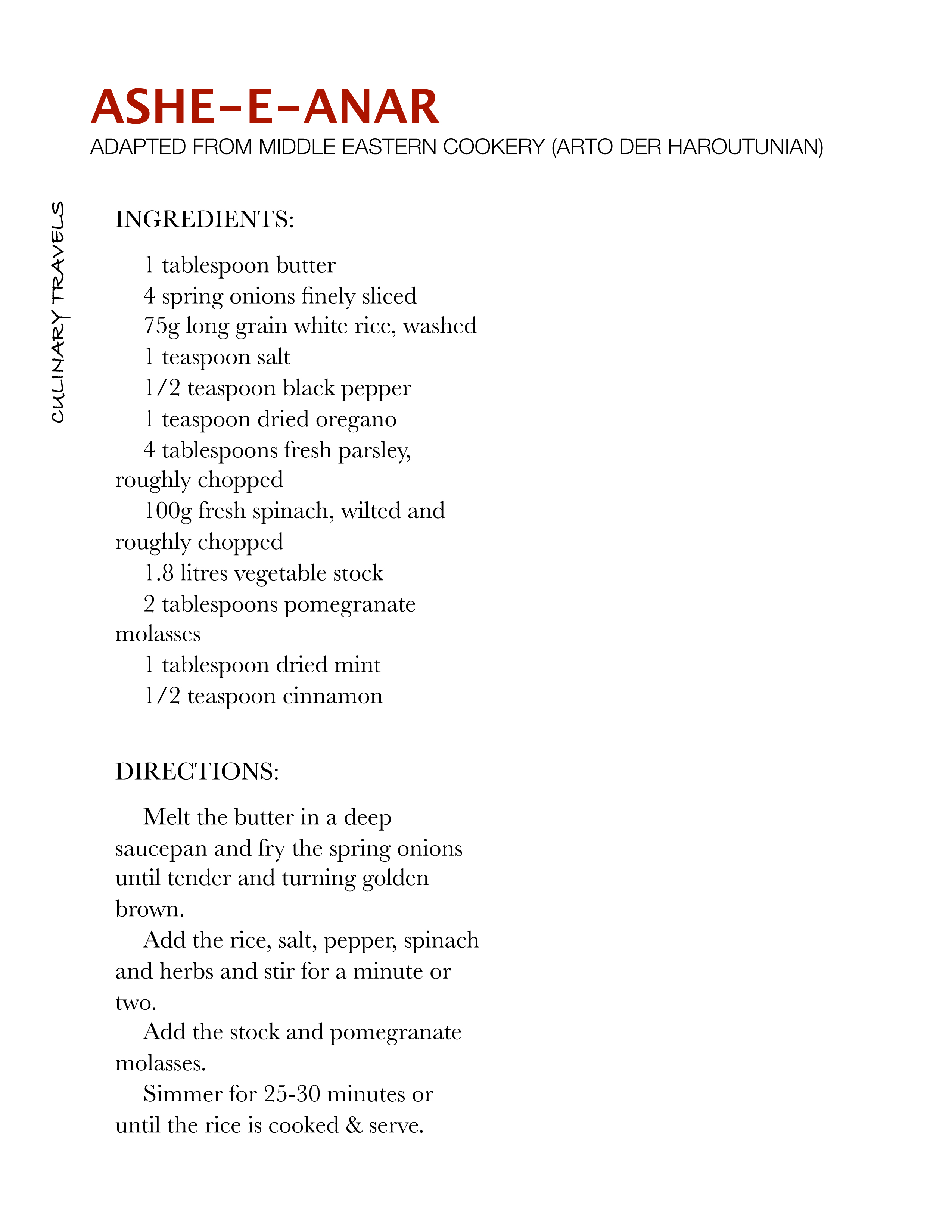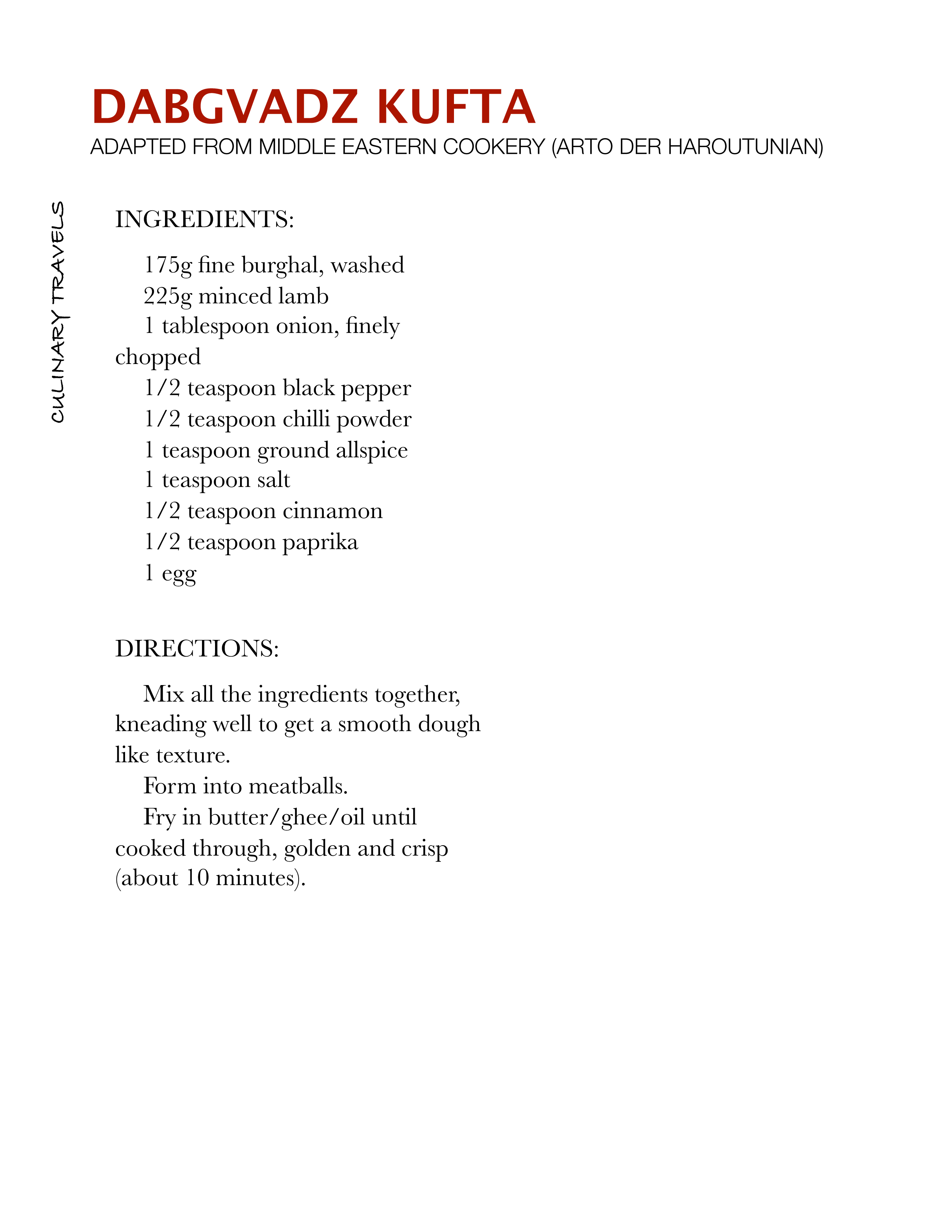
Your branches are a pomegranate orchard
with all precious fruits, henna and roses
saffron and spikenard, cassia, cinnamon
with frankincense trees, myrrh and aloes
all perfect spices …
Eat, my friend, drink –
lover be drunk with love
(The Song of Songs)
It’s time again for the Daring Bakers challenge. This month’s challenge is brought to us by Karen of Baking Soda and Zorra of 1x umruehren bitte aka Kochtopf. They have chosen Tuiles from The Chocolate Book by Angélique Schmeink and Nougatine and Chocolate Tuiles from Michel Roux. They also gave us a savoury option too – Tuilles from The French Laundry Cookbook (Thomas Keller).

I took the savoury option but did alter the recipe ever so slightly, since when did I not? Instead of scattering the tuille batter with sesame seeds I used pomegranate powder to dust them with. Pomegranate powder is a reddish brown powder, also called anardana, which is made from the dried seeds of pomegranates; it has a tangy almost tart taste.

The tuiles were incredibly easy to make, much easier than I anticipated when I saw the challenge first time round but I have to say as much as I love The French Laundry Cookbook (Thomas Keller) I was highly disappointed with the result of the tuiles, they were greasy and had a very poor mouth-feel when eaten plain, on serving with the accompaniment they were ever so slightly better but whether that was my lack of skill or a problem with the recipe I don’t know, I’ll be interested to know how other Daring Baker’s found them.
We were allowed to either form the shape of the tuiles pre or post baking, I did it half way through baking – at the point in the recipe (see below) where you can mould the tuiles I cut them out using various shaped cookie cutters, which worked quite well I think.
So what was the accompaniment? Well it had to fulfil the following criteria of being light and I took this to mean healthy too: I chose a pomegranate soup (Ashe-e-Anar) from my lovely new book Middle Eastern Cookery (Arto Der Haroutunian).

Middle Eastern Cookery (Arto Der Haroutunian) is a fabulous book which has been out of print for several years, rereleased last year and to quote The Oxford Times:
it is the seminal work from the Middle East. It was his belief that the rich culinary tradition of the Middle East is the main source for many of our Western cuisine. As it contains every possible recipe from the region, which are peppered with anecdotes on life, food, and Middle Eastern culture, this book will provide real foodies with a classic they can enjoy for years to come.
They certainly haven’t got it wrong in my opinion, despite the book containing absolutely no pictures the recipes are so vividly portrayed in words leaving the reader absolutely drooling at the images they conjure in their mind. If you haven’t seen a copy I recommend you get your hands on one fast.
The pomegranate soup seemed to fit the bill so well, light, healthy, refreshing and cleansing, what could be a better alternative? For once I left the recipe alone, with one minor addition, I scattered pomegranate seeds over the top of the soup, how could I resist? Pomegranate seeds are so pretty aren’t they, little juicy, red pearls of goodness. No wonder scholars debate if the pomegranate was the original forbidden fruit bitten into by Eve in the Garden of Eden; how could she deny herself the pleasure?
Pomegranates are not only seen in that poor light, in fact they are held in high esteem in both the Jewish and Christian religions, Exodus 28:33-34 directed that images of pomegranates be woven onto the hem of the me’il (“robe of the ephod”), a robe worn by the Hebrew High Priest. 1 Kings 7:13-22 describes pomegranates depicted on the capitals of the two pilars (Jachin and Boaz) which stood in front of the temple King Solomon built in Jerusalem. It is said that Solomon designed his coronet based on the pomegranate’s “crown” (calyx). Jewish tradition teaches that the pomegranate is a symbol for righteousness, because it is said to have 613 seeds which corresponds with the 613 mitzvot or commandments of the Torah. For this reason and others, many Jews eat pomegranates on Rosh Hashanah. However, the actual number of seeds varies with individual fruits. It is also a symbol of fruitfulness. The pomegranate is one of the few images which appear on ancient coins of Judea as a holy symbol, and today many Torah scrolls are stored while not in use with a pair of decorative hollow silver “pomegranates” (rimmonim) placed over the two upper scroll handles. Pomegranate is one of the Seven Species (Hebrew: ???? ??????, Shiv’at Ha-Minim), the types of fruits and grains enumerated in the Hebrew Bible as being special products of the Land of Israel. For the same reasons, pomegranates are a motif found in Christian religious decoration. They are often woven into the fabric of vestments and liturgical hangings or wrought in metalwork. Pomegranates figure in many religious paintings by the likes of Sandro Botticelli and Leonardo da Vinci, often in the hands of the Virgin Mary or the infant Jesus. The fruit, broken or bursting open, is a symbol of the fullness of his suffering and resurrection.
Who would have thought a fruit would have such history? I digress, so back to the soup.

Pomegranate soup is popular throughout the Caucasus and Northern Iran, it has recently become popular in Israel too due to immigration.
The soup is sweet but sour, warming and filling but light at the same time. It should be served hot but I’d be tempted, should the weather ever brighten up here, to serve it at room temperature on a warm, sunny evening.
The sweet-sour balance comes from the sharp pomegranate molasses and the warming sweetness of the cinnamon with the pomegranate seeds bursting like living garnets to add just the right splash of tartness to each spoonful.
The inclusion of a small amount of long grain rice really makes the soup a meal in itself but it is customary in many areas in the Middle East to add some Kibbeh (meatballs) to the dish too. I partook in this tradition and included Dabgvadz Kufta (Fried Kibbeh Meatballs) too. However to keep them crunchy I served them in a separate bowl rather than dropped into the soup, allowing everyone to help themselves as they wanted them.

Crisp, fragrant, gently spiced bites of bulgur wheat and minced lamb, dotted with pomegranate seeds, seemed the perfect accompaniment











What Our Followers Say
"Oh yum!!! I could eat one or two right now!"
Sami Tamimi
"Such a beautiful pic!"
Nigella Lawson
Our list of things to do in Cork has just expanded hugely thanks to Culinary Travels.
Triskel Art Centre Cork